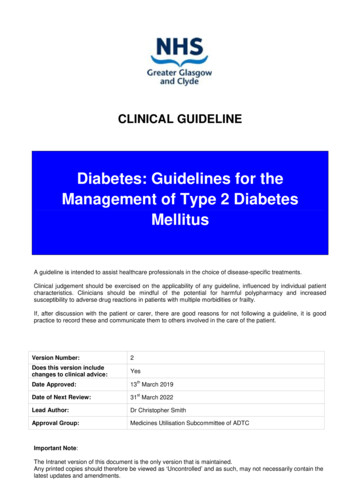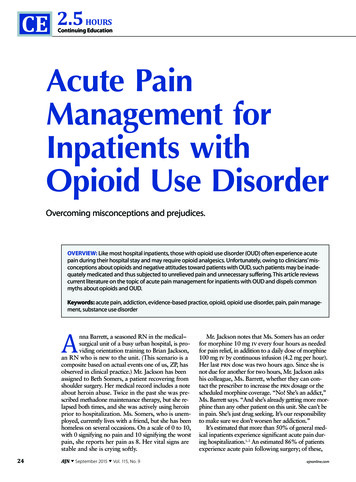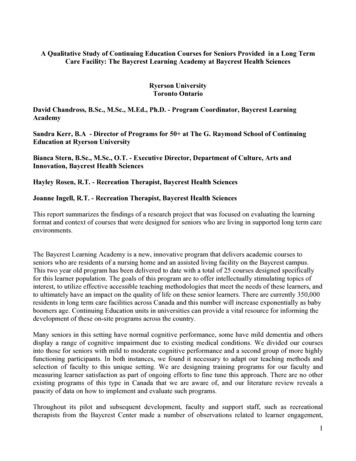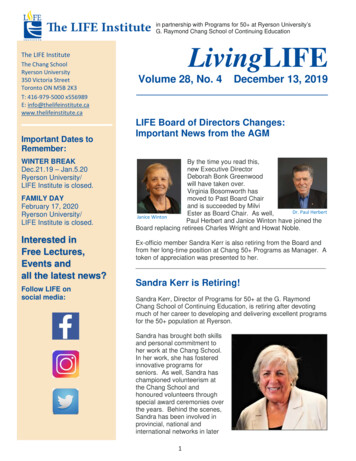
Transcription
DIABETES MELLITUSOFFERED BYNURSES RESEARCH PUBLICATIONCONTINUING EDUCATIONAuthorDeborah Brown R.N., BSNCopyright 20021
TABLE OF CONTENTS2Instructions 6Course Objectives 8Chapter IIntroduction to Diabetes Mellitus 9The Role of Insulin 11Risk Factors ter IIDiabetes Mellitus Type I (IDDM) DKA Treatment of DKA Treating Type I Treatment Goals for Type I Diabetes Personal Goals for Type I Diabetes Type 2 (NIDDM) Treatment Goals For Type 2 Diabetes Personal Goals for Type 2 Diabetes Gestational Diabetes Pregnancy and Diabetes HHNC Hypoglycemia Chapter IIILaboratory Tests and Monitoring Laboratory Procedures Fasting Blood Glucose Oral Glucose Tolerance Test Cortisone Glucose Tolerance Test Intravenous Glucose Tolerance Test Blood Sugar Monitoring Urine Tests Chapter IVInsulin and Oral Antidiabetic Agents 3
40404141Insulin Facts Characteristics of Insulin Premixed Insulin Storage of Insulin TABLE OF 7273747475777879808083Allergic Reactions and Mild Reactions Types of Insulin Novolin Pen Injector The Insulin Pump Insulin Reactions Oral Antidiabetic Agents Types of Oral Antidiabetic Agents Drug Combinations Insulin and Oral Therapy Chapter V The Diabetic Diet What is a Calorie Exchange System Exchange Lists Sample of 1500-Calorie Diet Sample of Exchange Lists Carbohydrates Proteins Fats Fiber Alcohol Points to RememberMeal Plan ChartChapter VI Diabetic Foot and Wound Conditions and Treatment Foot and Wound Problems Peripheral Vascular Disease Neuropathy Things to Avoid Assessment of the Diabetic Foot Wound Chapter VII Complications of Diabetes Mellitus Neuropathy Types of Neuropathy Causes of Neuropathy 4
838386868787Diagnosing Neuropathy Treatment of Neuropathy Diabetic Retinopathy Types of Retinopathy Prevention and Treatment of Retinopathy Cataracts TABLE OF CONTENTS88898990909091929495Glaucoma Diabetes and Nephropathy Risk Factors for NephropathyPrevention of NephropathyTreatment Choices for ESRD Hemodialysis Peritoneal Dialysis Kidney Transplant Blood Vessel Complications Summary of Complications 97Chapter VIII The Family and Diabetes 98The Child and Diabetes 101Chapter IX Coping With Diabetes 102104Nursing Implications.References5
Course Objectives(Overall behavioral objectives of the entire course)At the end of this course, each nurse will be able to:1. Define diabetes mellitus as a genetically determined disorder of metabolism.2. Identify the manifestations of insulin deficiency and the inability to toleratecarbohydrates.3. Identify diabetes mellitus in its completely developed state characterized byfasting hyperglycemia, microangiopathic and arteriosclerotic vascular disease andneuropathy.4. Identify the various types of lesions that may lead to insulin insufficiency.5. Discuss and identify insulin as a hormone that regulates the amount of glucose inthe blood.6. Identify and discuss Type 1, Type 2, and Gestational diabetes and their respectivegoals.7. Identify the factors that increase the risk of diabetes.8. Identify the factors in the development of DKA and its treatment.9. Discuss the pathogenesis of diabetic ketoacidosis.10. Identify the pathophysiology of hypersosmolar coma and its treatment.11. Identify and discuss hypoglycemia.12. Identify the laboratory procedures used in the diagnosis and treatment of diabetesmellitus.13. Identify the different types of insulin and their use.14. Understand blood sugar monitoring and blood sugar fluctuations.6
15. Identify oral hypoglycemic agents and their use.16. Identify the diabetic diet as a well-balanced meal plan tailored to the individualneeds, tastes, activity level and life-style.17. Understand the variety of complications associated with diabetes mellitus andtheir treatment.7
CHAPTER IINTRODUCTION TO DIABETES MELLITUSTHE ROLE OF INSULINANDRISK FACTORS8
INTRODUCTIONDiabetes is a condition that affects the way the body uses food. A genetically determineddisorder of metabolism, it is manifested by insulin deficiency and the inability to toleratecarbohydrates.Diabetes in a completely developed state is characterized by: Fasting hyperglycemia Microangiopathic and arteriosclerotic vascular disease NeuropathyThe incidence of diabetes is high, with more than 16 million Americans having someform of the disease. More than 700,000 new cases are diagnosed each year.The term diabetes covers a wide spectrum of disability ranging from the elderly, asymptomatic individual with glucose intolerance, to the young patient dependent onexogenous insulin.The manifestation of diabetes mellitus can be divided into two main groups: The acute diabetic syndrome characterized by hyperglycemia, ketoacidosis, and ifuntreated, death. The chronic diabetic characterized by diffuse microangiopathy involving vitaltissue.Diabetes has a heterogeneous etiology. Different types of lesions may lead to insulininsufficiency along with environmental factors, causing an alteration in the function andintegrity of the beta cells in the pancreas. These factors include pregnancy, diet, obesity,and infective agents such as the mumps virus.THE ROLE OF INSULINInsulin is a hormone produced by the pancreas. The pancreas either produces no insulin,too little insulin, or the body does not respond to the insulin produced. This causes abuild-up of glucose in the blood, creating high glucose levels in the body since the bodyis unable to utilize the glucose for energy. This high concentration of glucose in theblood is called hyperglycemia.During the normal digestive process, the body converts food into glucose to be used bythe body’s cells as an energy source.Foods eaten are made of carbohydrates, proteins, and fats. These foods are broken downto provide fuel for the cells, which are converted into glucose, a simple sugar.9
Glucose enters the cells through receptor sites that accept insulin, which facilitates thepassage of glucose to the cell. Excess glucose is stored in the liver and muscles in theform of glycogen. When the body is low on fuel and the blood sugar is low, glycogen,stored in the liver, is released to form glucose. The liver is also able to make new sugar,which it gets from protein taken from muscles.The pancreas is located in the abdomen behind the stomach. It is attached to the smallintestine and spleen. Inside the pancreas are groups of cells called Islets of Langerhans.The Isles of Langerhans comprise approximately 1% to 3% of the weight of the pancreas.These islet cells can be classified as A, B, D, PP cells. Each type cell contains a specifichormone with the B cell, or beta cell, being insulin.Beta cells regulate blood glucose levels constantly and deliver the required amounts ofinsulin needed to transfer glucose into the cells. This process keeps glucose levels in thenormal range of 60-120mg/ml. Glucose has difficulty entering the cells when there islittle or no insulin in the body, or when there is an inappropriate response to the insulinproduced.When blood glucose rises above 180mg/ml, or what is termed the kidney threshold, it isremoved from the body in the urine. This is called glycosuria. Often, people with longterm diabetes or kidney disease develop a high kidney threshold, which means thatglucose does not spill over into the urine until the blood sugar is extremely high.The regulation of glucose is closely regulated in normal individuals. In healthy people,the secretion of insulin and the amount of glucose are closely coordinated. The amountof glucose released by the liver is directly proportionate to the amount of glucose used bythe tissues. Therefore, if glucose concentration decreases, insulin concentration deceases,and if glucose concentrations increase, so does the need for insulin.In the diabetic, the renal tubules are unable to absorb all of the glucose filtered by theglomeruli. The renal excretion of glucose requires excretion of water and produces anosmotic diuresis. This diuresis is called polyuria or excessive urination. Polyuria cancause dehydration, resulting in dry skin and blurred vision, which is due to fluctuation inthe amount of glucose and water in the lenses of the eye during dehydration. Glucoseneeds water to flow from the body. Loss of water causes an increase in the serumpolarity that stimulates the thirst center in the hypothalamus. This results in a conditioncalled polydipsia, or excessive thirst. Symptoms may range from pronounced to nothingmore than a dry mouth.Polyphagia, or excessive hunger, is caused by the body’s inability to transfer, via insulin,glucose through the receptors into the cells. Without glucose as fuel, the cells starve.Since the cells cannot produce energy, the diabetic patient feels weak and tired. Theglucose needed for fuel is being lost through the urine. Weight loss occurs in people thatproduce no insulin because fuel does not enter the cells.10
When insulin is low, the body breaks down as fuel, and rapid weight loss occurs. As fatcells breakdown, fatty acids are formed. These fatty acids pass through the liver to formketones. Ketones are excreted in the urine. This is called ketonuria.FACTORS THAT INCREASE THE RISK OF DIABETESHeredity:There is approximately a 5% risk of developing diabetes if your mother, father, orsibling has diabetes. The risk increases to almost 50% of reported cases, ifparents or siblings have diabetes and are overweight.Obesity:80% of people with Type 2 diabetes are overweight, with symptoms disappearingwith weight loss.Age:Fewer beta cells produce insulin with age.Viruses:Certain viruses may destroy beta cells.Faulty Immune System:Multiple factors may cause the immune system to destroy beta cells, such asinfection.Physical Trauma:Injury or trauma may destroy the ability of the pancreas to produce insulin.Drugs:Drugs used for other conditions could cause the development of diabetes.Stress:Hormones at times of stress may block the effectiveness of insulin.Pregnancy:Hormones produced during pregnancy can block the effectiveness of insulin.11
CHAPTER IIDIABETES MELLITUSTYPE IDKATYPE 2HHNCGESTATIONAL and PREGNANCYHYPOGLYCEMIA12
TYPES OF DIABETESTYPE I (IDDM)People who have diabetes fall into one of two categories, referred to as Type 1 and 2.Type 1 diabetes, also known as insulin dependent diabetes mellitus, (IDDM), accountsfor approximately 10% of diabetes cases. In Type 1, the body does not produce insulin.Type I diabetes is usually diagnosed during childhood or young adulthood, which is whyit is referred to as juvenile diabetes. This disease has a sudden onset with symptoms suchas polydipsia, polyphagia, polyuria, weight loss, and fatigue. Type I diabetes tends to beunstable and is very sensitive to exogenous insulin and physical activity.Symptoms are caused by hyperglycemia and a breakdown of body fats. In order forproper metabolism of carbohydrates, fats, and proteins to take place, insulin must bepresent. If insulin is not present, multiple changes in the products of metabolism willoccur.DIABETIC KETOACIDOSISDKAAs insulin deficiency persists, hyperglycemia and glucosuria intensifies as ketonemiadevelops. Symptoms continue to progress to dehydration, resulting in low blood volume,increased pulse rate, and dry flushed skin. The plasma pH begins to drop as acetone andketones breakdown. When the plasma level reaches 7.2, the respiratory center isstimulated, and the patient’s breathing becomes shallow and rapid (Kussmaul respiration)with a fruity odor. This is the body’s way of trying to prevent a further decline in pH.The increased loss of CO2 from the lungs reduces plasma carbonic acid to acceptablelevels. Metabolic acidosis occurs when the body’s buffer system is unable to maintainnormal pH with the assistance of the respiratory compensatory mechanisms. A continueddecline in pH with progression of symptoms including stomach pains, vomiting, anddecreased level of consciousness, results in diabetic ketoacidotic coma (DKA) and death.Protein catabolism is a result of insulin deficiency. This causes a release of nitrogen andpotassium into the circulation. Late in ketoacidosis, renal function falters due tohypovolemia and dehydration. Urinary loss exceeds that of electrolytes so that plasmasodium and potassium may be increased in spite of the total body deficiency of theseions. With the administration of insulin, the potassium re-enters the cells along with theglucose. Fluid therapy causes expansion of plasma volumes, and a return of normal renalfunction, which is essential.13
Factors in development of DKA Failure to take insulinInsufficient amount of insulin takenInfectionNausea/ vomiting with omission of insulin since food isn’t eatenResistance to endogenous insulin produced by the bodyDKA TREATMENT SUMMARYNURSING IMPLICATIONSDehydration:The patient in DKA is treated initially with intravenous fluids, progressing to oral fluidsas the patient’s condition improves. Urinary output, vital signs and specific gravity aremonitored closely in order to evaluate the effectiveness of fluid replacement. Normalsaline is usually the IV solution of choice. The adult fluid deficit is approximately 6-12liters.Insulin:Patients in DKA require rapid-acting insulin. Regular insulin U-100 is administered IVP,or in severe cases of DKA, an insulin drip is started. Insulin is given until the bloodsugar reaches about 250mg/ml. An insulin drip consists of placing 100 units of regularinsulin in 500cc’s of D5W solution. The drip is then titrated according to the desireddosage per hour.Electrolytes:Electrolyte replacement is managed based on laboratory results. As hydration progresses,laboratory values will change as the electrolytes move from compartment to fluidcompartment. Potassium replacement becomes more crucial with the administrationof insulin. Insulin causes potassium to move into the intracellular compartment at thetime acidosis is corrected. Potassium chloride is given IV up to 10 mEq/hour or
8. Identify the factors in the development of DKA and its treatment. 9. Discuss the pathogenesis of diabetic ketoacidosis. 10. Identify the pathophysiology of hypersosmolar coma and its treatment. 11. Identify and discuss hypoglycemia. 12. Identify the laboratory procedures used in the diagnosis and treatment of diabetes mellitus. 13. Identify .











